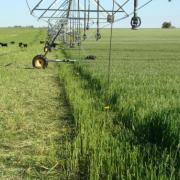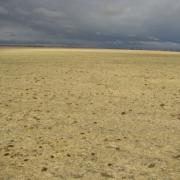![]() Waste to Worth home | More proceedings….
Waste to Worth home | More proceedings….
Abstract
Typically cattle producers can have improved animal performance through controlled systems such as an open lot feedlot. Open lots provide for improved control of diet, health, and monitoring of activity of the animals. Feeding areas such as these also can have disadvantages such as solid manure accumulation, surface water contamination when runoff water is uncontrolled, such systems are labor and machine intensive, and can contribute herd health issues because of high stocking densities, dust, or mud. Forage based grazing can negate many of these issues and is arguably more sustainable and environmentally friendly. However intensive grazing strategies must be employed to obtain comparable productivity. Development of technology that allows for these benefits is needed. Cross fencing and rotational grazing practices would benefit from more flexible and less labor intensive ways of controlling the grazing area.

Figure 1. Calves waiting for new windrows of oats. |
A device has been developed by UNL Extension that adapts a center pivot irrigation system into a moveable fence by placing the fence on the center pivot structure. Livestock producers can move anywhere from several hundred to several thousand feet of fence by simply moving the center pivot (while not irrigating). Swath grazing, forage grazing, or crop residue grazing can be accomplished more efficiently by only allowing minimal access to the forage. Essentially moving the animals to the feed rather than bringing the feed to the animals. Advancing a cross fence periodically not improves the grazing efficiency, but it encourages a natural spread of manure and gives the producer more control of remaining crop residue, a necessary requirement to maintain pasture status and avoid the Animal Feeding Operation designation. The device was tested on working farms over a two year period and improved profitability and minimized environmental impact compared to the operator’s previous practices.
Can Intensive Forage Grazing Be Profitable?
The project started from a request for some alternatives to help reduce the cost of gain for feeder calves in 2010. Eliminating the forage activities of baling / stacking, transporting, grinding, feeding and also the spreading of manure can significantly reduce labor and equipment expenses. Keeping feeder calves in a grazing operation instead of concentrated feeding operation has the potential to minimize surface water contamination. The health and welfare of the calf can be improved by having a lower stock density, larger area for exercise, and with crop residue a reduced impact of dusty or muddy conditions. Forage based grazing is arguably more sustainable and environmentally friendly than concentrated feeding areas. However intensive grazing strategies must be employed to obtain comparable productivity. Development of technology that allows for these benefits is necessary. Cross fencing and rotational grazing practices would benefit from more flexible and less labor intensive ways of controlling the grazing area.

Figure 2. Calves grazing standing oats. |
What Did We Do?
The project was focused for fall / winter grazing opportunities for newly weaned spring born calves of the semi-arid region of western Nebraska. A successful grazing operation of windrowed or standing forage will have to include a method of controlling daily forage intake through cross fencing( Figures 1 & 2). This would reduce waste and give the producer a feedlot like control of dry matter intake so a desired daily gain could be achieved. Current portable fencing has to be manually installed and moved which is labor intensive especially in frozen soils. A new development in portable fencing was developed by UNL Biological Systems Engineering that a device attaches to a center pivot and properly suspends an electrified wire under tension. This gives the producer a portable cross fence (1,300 ft) that can be moved by the center pivot’s control panel or wirelessly with a computer.
In the fall of 2011 and 2012, four grazing programs were developed to demonstrate this new cross fence. Two were fall planted oats and two were grazed corn stalk residues. The fall oats were grazed as a standing forage and also as a windrow. The corn stalk residue was grazed in a manner to minimize the overgrazing of downed corn ears and reduce the protein supplement.
What Have We Learned?
The projects demonstrated that calves can be successfully maintained in theses grazing systems. The management and the relocations of the cross fence was done easily done though the center pivot’s control panel (average time of 15 minutes). The

Figure 3. Natural manure distribution. |
forage quality of the windrowed oats maintained its quality throughout the 105 (fall 2011) and the 120 (fall 2012) day grazing period. In 2011 the oat forage deteriorated only 17% in crude protein and 14% in total digestible nutrients. In 2012 the oat forage deteriorated only 2% in crude protein and 3% in total digestible nutrients. Cost savings in the fall oat grazing are reported at$7,268.85 total or $28.70 / ton grazed ($22.16 per head) for 105 days in the 2011 trial. In the 2012 trial the savings were a total of $4,625.60 or $29.50 / ton ($25.70 per head) for a 120 day trial. The cost savings for the corn stalk residue weren’t measured. The project only demonstrated the control of grain intake in the calves or cow, which it accomplished. The manure was naturally spread throughout the fields and the cattle health and welfare was maintained (Figure 3).
Future Plans
A future plan is being developed to continue to demonstrate the ability to control dietary intake of calves or cows on irrigated forages. With a portable and mechanically moveable cross fence the conveniences of a concentrated feeding operation can be placed into a grazing operation in large scale.
Authors
Jason Gross, Engineering Tech, UNL Extension, jgross3@unl.edu
Additional Information
http://water.unl.edu/web/manure/small-afos
The authors are solely responsible for the content of these proceedings. The technical information does not necessarily reflect the official position of the sponsoring agencies or institutions represented by planning committee members, and inclusion and distribution herein does not constitute an endorsement of views expressed by the same. Printed materials included herein are not refereed publications. Citations should appear as follows. EXAMPLE: Authors. 2013. Title of presentation. Waste to Worth: Spreading Science and Solutions. Denver, CO. April 1-5, 2013. URL of this page. Accessed on: today’s date.

